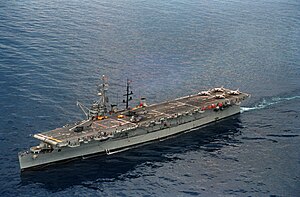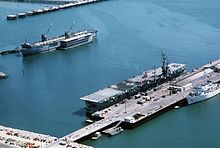Spanish aircraft carrier Dédalo
 Dédalo at sea on 1 June 1988
| |
| History | |
|---|---|
| Name | Dédalo |
| Laid down | 16 March 1942 |
| Launched | 4 April 1943 |
| Acquired |
|
| Refit | 1976 |
| Stricken | August 1989 |
| Fate | Scrapped 2002 |
| Notes | Served in United States Navy 1943–1947 and 1948–1955 as USS Cabot |
| General characteristics | |
| Displacement | 11,000 |
| Length | 622.5 ft (189.7 m) |
| Beam |
|
| Draft | 26 ft (7.9 m) |
| Installed power | 100,000 shp (75,000 kW) |
| Propulsion |
|
| Speed | 32 knots (59 km/h) |
| Complement | 1112 |
| Sensors and processing systems | SPS-6 radar |
| Armament | 26 × Bofors 40 mm guns |
| Aircraft carried |
|
| Aviation facilities |
|
Dédalo (Spanish for
History

In 1953 the Spanish government

Finally in 1967, after over twelve years in
On 8 November 1972[4][citation needed], a Harrier was successfully tested on the Dédalo deck, a first in the history of the plane.
It was decided to order and deploy
She then typically carried an air group of eight AV-8S fighters, four Sea King
During her Spanish service, Dédalo logged 1,650 days' steaming, covering 300,000 nautical miles (560,000 km), registering 30,000 landings and takeoffs, losing an AV-8A and three AB 212ASW helicopters to accidents.[6][unreliable source?]
Disposal
Replaced by the Spanish-built S/VTOL carrier Príncipe de Asturias in 1988, the Dédalo was struck by the Spanish Navy in August 1989, and she was given to a private organization in the U.S. for use as a museum ship. However, that private organization was unable to pay its creditors, and on 10 September 1999, the ship was auctioned off by the United States Marshals Service to Sabe Marine Salvage of Rockport, Texas. The scrapping of the hulk was completed in 2002.[citation needed]
See also
References
- ISBN 0-87021-918-9, p. 111.
- ^ Los Huey Cobra de la Armada española (12 mayo, 2018)
- ^ ¿Otro portaaviones Dédalo?
- ^ a b es:Dédalo (portaaeronaves)
- ^ The full story of the Harrier "Jump-Jet" Part Three – Harriers in Service and the Falklands War
- ^ Wikispaces.com, R01 Dédalo
